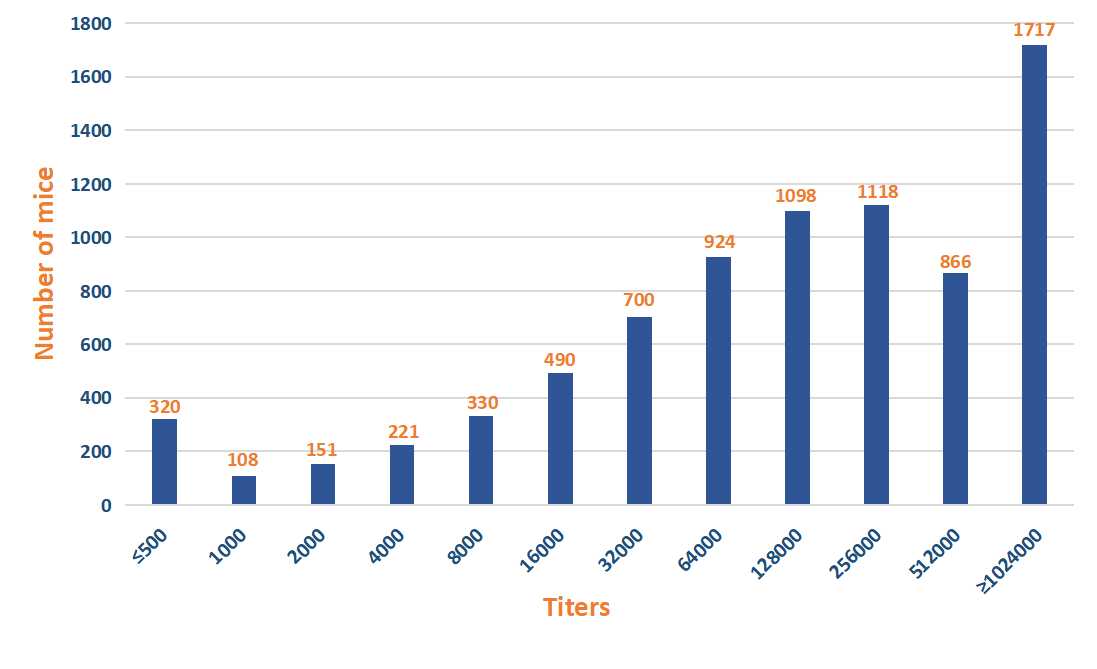Product Information
This adjuvant is a pH-neutral, thick solution and its main component is a high molecular polymer with strong hydrophilic groups on its side chains, which makes the product miscible with aqueous solutions and eliminates the need for emulsification during use. The hydrophobicity of its main chain allows it to bind to protein antigens (including protein-coupled peptides or small molecule compounds) and keep the protein structure unaffected. Therefore the bound antigens can be released slowly after injection into the animals, thus achieving the gradual stimulation of the immune system.
This adjuvant is non-toxic and non-immunogenic, so the animal is healthy after immunization (unless the antigen itself is toxic), it will not induce granulomas, and the animal will not produce antibodies against the adjuvant itself.
The immunizing effect of this adjuvant is similar to or slightly stronger than that of Freunds adjuvant, but the toxicity is much lower.
We have immunized more than 8000 BALB/c mice with this adjuvant and successfully developed high quality monoclonal antibodies against more than 2,000 antigens for Western blot, IHC, IF, IP, Neutralization, Indirect ELISA, and Sandwich ELISA. The serum titers of these mice were distributed as follows:

The serum titers distribution of 8043 BALB/c mice immunized by our company (Cut-off OD=0.3) was based on the fact that the mice were raised in SPF environment, and 90% of the immunized antigens were recombinant proteins and 10% were peptides coupled with carriers. A total of 3 injections were given in a 48-day cycle.
Storage
Temperature has little effect on the preservation of this product, it can be stored between 4-40℃ prior to opening, preservation period of 5 years. Once opening the lid, please put it at 4℃ to prevent the growth of bacteria, and it is best to use it up within one month. If it can not be used up within one month, it is recommended to take it aseptically each time or divide it into several tubes, or you can cover the lid after taking it and heat it at 56℃ for half an hour, and then put it at 4℃ again after cooling naturally.
Usage
1. Adjust the antigen concentration to 0.5-1.0 mg/mL with PBS or saline. Take the appropriate volume of antigen according to the immunogenicity:
a. Most proteins are immunized at 40-80 μg per mouse per injection; strong immunogen can be reduced to 20 μg per mouse per injection;
b. Peptides or small molecule compounds with coupled carriers are immunized at 80-150 μg per mouse per injection (excluding the amount of carrier);
c. Whole-viral or whole-bacterial antigens have not been tested so far, and it is recommended to be converted into the mass of total protein and refer to the protein antigen dose for immunization.
2. Open the adjuvant bottle cap in the direction of the arrow, and handle carefully to prevent the aluminum cap from scratching. Mix equal volumes of adjuvant and antigen in a total volume of 100-300 μL per mouse, and immunize with 30-50 μL of adjuvant per site, either subcutaneously or in the groin.
3. The immunization is boosted at the same dose and in the same manner on day 21, and the serum titer detection can be performed on day 35. Approximately 70% of the mice will reach a higher titer on day 35.
4. If the titer is lower than expected on day 35, a booster immunization at the same dose and in the same manner can be given on day 35. The serum titer detection is performed on days 45-48, when at least 95% of the mice have reached peak titers. If the titer is still lower than expected, additional booster immunizations usually do not substantially improve the effectiveness of the immunization.
5. If the purpose of the experiment is to prepare monoclonal antibody by cell fusion from spleen, it is recommended to perform a shock immunization about two weeks after the last booster immunization, and the dose of antigen immunization should be one-third of the first immunization, and the antigen should be diluted to 0.3 mL with PBS or saline and injected intraperitoneally. Cell fusion should be performed 48-72 hours after the shock immunization.
Cautions
1. This adjuvant is more effective in mice and slightly less effective in rabbits or other animals.
2. Before immunization, please make sure the antigen is not toxic to animals. The antigen buffer does not contain harmful ingredients such as guanidine hydrochloride, detergents, etc., but it can contain urea below 4 M. The buffering capacity of this adjuvant is stronger than that of PBS, please make sure that the pH of the antigen solution is between 5 and 9, so that it can be buffered to neutral after mixing with the adjuvant.
3. Divalent metal ions such as Fe2+, Mg2+, Mn2+, Cu2+, and Ca2+ may affect the stability of this adjuvant and may form precipitations, so it is preferable not to contain a high concentration of divalent metal ions in the antigen (not higher than 1 mM).
4. Too small a volume of antigen in an immunization may be lost during manipulation due to container adsorption, and too large a volume may result in slow release of antigen which may lead to low titer.
5. When opening the cap, please follow the direction of the arrow, and operate carefully to prevent the aluminum cap from scratching your hands.
Cited in Article as
PR40009, Mouse Adjuvant, Proteintech, IL, USA
Documentation
| Datasheet |
|---|
| Mouse Adjuvant PR40009 datasheet |
